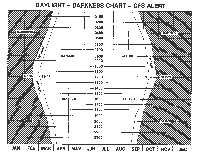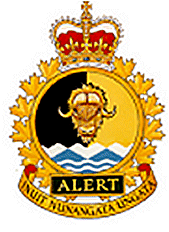CFS Alert was named after a British ship, HMS Alert, which wintered off
Cape Sheridan 9.7 km east of the present station in 1875-76. Alert was
first settled in the early 1950s as a weather station of the Joint Arctic
Weather Station system. The Canadian military station was established in
1958.
 The most noticeable difference in Alert's environment compared to southern
Canada is periods of full daylight and full darkness, lower temperatures
and lower annual precipitation. From April 8 to September 5, there is no
nighttime. The sun rises to approximately 30 degrees above the horizon at
noon and dips to 16 degrees above the horizon at midnight. From October 10
to March 1, there is no direct sunlight. Between these periods, there are
both nights and days of varied duration. The last sunset is on or around October 14th of each year while the first sunrise is on or around March 3rd.
The most noticeable difference in Alert's environment compared to southern
Canada is periods of full daylight and full darkness, lower temperatures
and lower annual precipitation. From April 8 to September 5, there is no
nighttime. The sun rises to approximately 30 degrees above the horizon at
noon and dips to 16 degrees above the horizon at midnight. From October 10
to March 1, there is no direct sunlight. Between these periods, there are
both nights and days of varied duration. The last sunset is on or around October 14th of each year while the first sunrise is on or around March 3rd.
Alert is a "hardship" post. No family members are permitted to live at the
station, and postings vary from three to six months long. Prior to the
station's downsizing, Communicator Research operators were virtually
guaranteed to serve a tour at Alert every four years. Many Communicator
Research operators have spent a total of five years in Alert during their
military career.
 Until 1980, only men were permitted in the Communicator Research occupation
and thus only men were posted to Alert. In September 1980, however, DND
began trial postings of a small number of women at Alert. In May 1983, as a
result of the success of those trials, the employment of women at Alert was
authorized and the Communicator Research occupation was opened to women.
In February 1994, the Government announced that Alert would be converted to
remote operations by 1997-98. CFS Alert is now a remotely operated facility
and the staffing has been reduced from 215 to 74 personnel, of whom only
seven are directly employed in operations. The remaining 67 personnel are
employed in airfield, construction engineering, food services and
logistical/administrative support functions. Canadian Forces personnel,
both men and women, from the navy, army and air force are employed in these
support functions.
Until 1980, only men were permitted in the Communicator Research occupation
and thus only men were posted to Alert. In September 1980, however, DND
began trial postings of a small number of women at Alert. In May 1983, as a
result of the success of those trials, the employment of women at Alert was
authorized and the Communicator Research occupation was opened to women.
In February 1994, the Government announced that Alert would be converted to
remote operations by 1997-98. CFS Alert is now a remotely operated facility
and the staffing has been reduced from 215 to 74 personnel, of whom only
seven are directly employed in operations. The remaining 67 personnel are
employed in airfield, construction engineering, food services and
logistical/administrative support functions. Canadian Forces personnel,
both men and women, from the navy, army and air force are employed in these
support functions.
The closest Inuit settlement is Grise Fiord, located about 725 km south.
Although Edmonton AB is the closest Canadian city at 3475, Stockholm Sweden
is only 3282 km away.
Other Distances to Alert
- Vancouver, BC 4264 km
- Montreal, QC 4135 km
- Winnipeg, MB 3990 km
- Halifax, NS 4183 km
- Toronto, ON 4344 km
- Resolute Bay, NT 1046 km
- Ottawa, ON 4151 km
- Thule, Greenland 676 km
- North Pole 817 km
|





